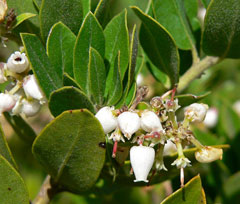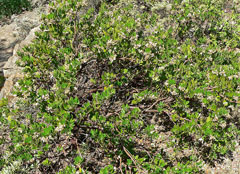 |
|
http://commons.wikimedia.org/wiki/User:Stan_Shebs |
 |
| http://commons.wikimedia.org/wiki/User:Stan_Shebs |
Translate this page:
Summary
Physical Characteristics

 Arctostaphylos tomentosa is an evergreen Shrub growing to 1.5 m (5ft).
Arctostaphylos tomentosa is an evergreen Shrub growing to 1.5 m (5ft).
See above for USDA hardiness. It is hardy to UK zone 8. It is in leaf all year, in flower from March to May. The species is hermaphrodite (has both male and female organs) and is pollinated by Bees. The plant is self-fertile.
Suitable for: light (sandy) and medium (loamy) soils and prefers well-drained soil. Suitable pH: mildly acid soils and can grow in very acid soils.
It can grow in semi-shade (light woodland) or no shade. It prefers moist soil. The plant can tolerate maritime exposure.
UK Hardiness Map
US Hardiness Map
Synonyms
A. cordifolia. A. vestita. Arbutus tomentosa.
Plant Habitats
Woodland Garden Sunny Edge;
Edible Uses
Edible Parts: Fruit Seed
Edible Uses:
Fruit - raw or cooked[2, 92, 105, 161]. Sweet, dry and mealy[61]. An important food for native tribes, it can also be dried for winter use[177]. When dried and baked into a bread it is relished by the native Indian tribes[2]. If harvested when not quite ripe, it can be used like a tart apple[2]. A cooling sub-acid drink can be made from the fruit[2, 257]. The fruit is about 8 - 10mm in diameter[200]. Seed - ground into a powder and used to make mush, biscuits etc[92, 257]. The seed is very small and would be difficult to separate from the fruit. It would be easier to dry the whole fruit, grind this into a powder and use it in soups etc[K].
References More on Edible Uses
Medicinal Uses
Plants For A Future can not take any responsibility for any adverse effects from the use of plants. Always seek advice from a professional before using a plant medicinally.
Antiseptic Appetizer Astringent Diuretic Stomachic Urinary
The dried leaves are used in the treatment of a variety of complaints[4]. These leaves should be harvested in early autumn, only green leaves being selected, and then dried in gentle heat[4]. A tea made from the dried leaves is strongly astringent, diuretic and an antiseptic for the urinary tract[4, 222]. It is much used for kidney and bladder complaints and inflammation of the urinary tract, but it should be used with caution[4, 21, 46, 172] because it contains arbutin which hydrolyzes into the toxic urinary antiseptic hydroquinone[222]. An infusion of the bark powder has been used in the treatment of lung haemorrhages[257]. A cider made from the fruit has been used as an appetizer to create appetite and treat stomach complaints[257]. Although the report does not specify, the cider was probably unfermented[K].
References More on Medicinal Uses
The Bookshop: Edible Plant Books
Our Latest books on Perennial Plants For Food Forests and Permaculture Gardens in paperback or digital formats.

Edible Tropical Plants
Food Forest Plants for Hotter Conditions: 250+ Plants For Tropical Food Forests & Permaculture Gardens.
More

Edible Temperate Plants
Plants for Your Food Forest: 500 Plants for Temperate Food Forests & Permaculture Gardens.
More

More Books
PFAF have eight books available in paperback and digital formats. Browse the shop for more information.
Shop Now
Other Uses
Dye Wood
A yellowish-brown dye is obtained from the leaves, it does not require a mordant[168]. The wood is used for making fine furniture[61].
Special Uses
References More on Other Uses
Cultivation details
Requires a deep moist well-drained light or medium lime-free loam[11, 166, 200] in sun or semi-shade but plants produce less fruit when they are grown in the shade[200]. Tolerates maritime exposure. This species is not hardy in the colder areas of the country, it tolerates temperatures down to between -5 and -10°c[200]. Very closely related to A. columbiana but with a more southerly range[11]. Plants can regenerate after a forest fire from a mallee-like base[166]. Plants resent root disturbance and should be placed in their final positions as soon as possible[11, 134].
References Carbon Farming Information and Carbon Sequestration Information
Temperature Converter
Type a value in the Celsius field to convert the value to Fahrenheit:
Fahrenheit:
The PFAF Bookshop
Plants For A Future have a number of books available in paperback and digital form. Book titles include Edible Plants, Edible Perennials, Edible Trees,Edible Shrubs, Woodland Gardening, and Temperate Food Forest Plants. Our new book is Food Forest Plants For Hotter Conditions (Tropical and Sub-Tropical).
Shop Now
Plant Propagation
Seed - best sown in a greenhouse as soon as it is ripe. Pre-soak dried seed in boiling water for 10 - 20 seconds or burn some straw on top of them and then stratify at 2 - 5°c for 2 months[11, 200]. The seed usually germinates in 2 - 3 months at 15°c[134]. When large enough to handle, prick the seedlings out into individual pots and grow them on in a cold frame or greenhouse for at least their first winter. Plant out in late spring or early summer. Cuttings of side shoots of the current season's growth, 5 - 8cm with a heel, August to December in a frame. The cuttings are very slow and can take a year to root[1, 78]. Division in early spring. Take care because the plant resents root disturbance. Pot the divisions up and keep them in a lightly shaded position in a cold frame or greenhouse until they are growing away actively. Layering in spring[200].
Other Names
If available other names are mentioned here
Native Range
NORTHERN AMERICA: United States (California)
Weed Potential
Right plant wrong place. We are currently updating this section.
Please note that a plant may be invasive in one area but may not in your area so it's worth checking.
Conservation Status
IUCN Red List of Threatened Plants Status :

Growth: S = slow M = medium F = fast. Soil: L = light (sandy) M = medium H = heavy (clay). pH: A = acid N = neutral B = basic (alkaline). Shade: F = full shade S = semi-shade N = no shade. Moisture: D = dry M = Moist We = wet Wa = water.
Now available:
Food Forest Plants for Mediterranean Conditions
350+ Perennial Plants For Mediterranean and Drier Food Forests and Permaculture Gardens.
[Paperback and eBook]
This is the third in Plants For A Future's series of plant guides for food forests tailored to
specific climate zones. Following volumes on temperate and tropical ecosystems, this book focuses
on species suited to Mediterranean conditions—regions with hot, dry summers and cool, wet winters,
often facing the added challenge of climate change.
Read More
Expert comment
Author
(Pursh.)Lindl.
Botanical References
1171200
Links / References
For a list of references used on this page please go here
Readers comment
| Add a comment |
|
If you have important information about this plant that may help other users please add a comment or link below. Only comments or links that are felt to be directly relevant to a plant will be included. If you think a comment/link or information contained on this page is inaccurate or misleading we would welcome your feedback at [email protected]. If you have questions about a plant please use the Forum on this website as we do not have the resources to answer questions ourselves.
* Please note: the comments by website users are not necessarily those held by PFAF and may give misleading or inaccurate information.
To leave a comment please Register or login here All comments need to be approved so will not appear immediately.
|
Subject : Arctostaphylos tomentosa
|
|
|
|